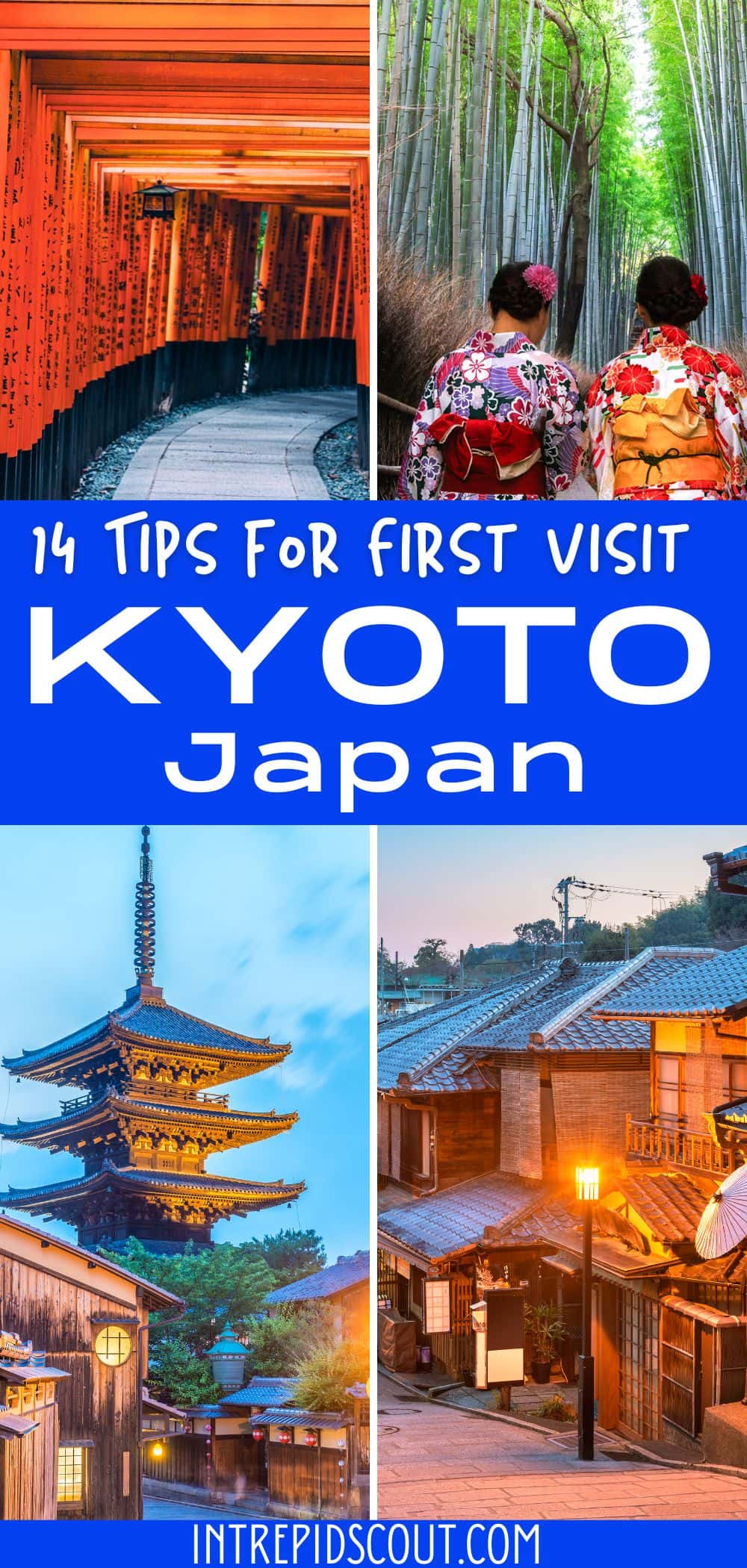This site uses affiliate links, meaning that if you make a purchase through our links, we may earn an affiliate commission.
Welcome to Kyoto, a city of rich cultural heritage and breathtaking natural beauty.
As a first-time visitor, you are about to embark on an enchanting journey through ancient temples, serene gardens, and vibrant streets lined with traditional wooden houses.
To ensure that your experience in Kyoto is truly unforgettable, we have curated a collection of valuable tips for first-time visitors to Kyoto to help you make the most of your visit.
From must-see attractions and local customs to transportation options and dining recommendations, this guide will provide you with the essential information you need to navigate the city with ease and immerse yourself in its captivating charm.
So, prepare to immerse yourself in the magic of Kyoto as we unveil a treasure trove of tips to enhance your first-time visit and create memories that will last a lifetime.
- 1. Discover Kyoto: 14 Valuable and Insightful Tips for First-Time Visitors to Kyoto
-
- 1.1. Master Kyoto's Public Transportation System
- 1.2. Embrace the Charm of Kyoto on Foot or by Bicycle
- 1.3. Find Your Ideal Retreat: Tips for Choosing Accommodation in Kyoto
- 1.4. Time Your Trip Right: When to Experience the Best of Kyoto
- 1.5. Discover Arashiyama - Kyoto's Scenic Gem
- 1.6. Unlock the Secrets of Nijo Castle (Tips for Enchanting Visit)
- 1.7. Explore Golden Pavilion (Kinkaku-ji)
- 1.8. Navigate Fushimi Inari Taisha Shrine with these Insider Tips and Insights
- 1.9. Discover the Magnificence of Kiyomizu-dera Temple
- 1.10. Explore Nishiki Market - A Gastronomic Wonderland of Kyoto's Culinary Delights
- 1.11. Explore Gion and Immerse Yourself in Kyoto's Traditional Charm
- 1.12. Reflect Along the Philosopher's Path
- 1.13. Visit Kyoto's Ginkaku-ji (Silver Pavilion)
- 1.14. Explore Pontocho - Kyoto's Enchanting Geisha District
- 2. Intrepid Scout's Tips for First Visit to Kyoto
Discover Kyoto: 14 Valuable and Insightful Tips for First-Time Visitors to Kyoto
Master Kyoto's Public Transportation System
When exploring Kyoto, one of the best ways to get around and experience the city like a local is by utilizing its efficient and extensive public transportation system.
From buses and trains to subways and taxis, Kyoto offers a range of transportation options that can seamlessly connect you to its iconic landmarks, hidden gems, and vibrant neighborhoods.
In this section, we will provide you with valuable insights and practical tips to help you navigate Kyoto’s public transportation system with confidence and ease. Whether you are planning to visit renowned temples, stroll through picturesque gardens, or indulge in delicious street food, mastering the art of getting around Kyoto will ensure that you make the most of your time and maximize your sightseeing opportunities.
So, let’s delve into the world of Kyoto’s public transportation and discover the secrets to traveling the city like a seasoned explorer.
- Kyoto’s Trains
Kyoto has 6 train lines and consists of the national JR Line and several local private lines. If you have a JR Rail Pass, then you will definitely want to use JR trains while you are exploring Kyoto!
You can download a free English-language PDF of Kyoto’s train system here.
- Kyoto’s Subway System
The Kyoto subway system is composed of two lines: The north-south Karasuma Line and the east-west Tozai Line. These two lines intersect in the middle of Kyoto, allowing you to transfer lines.
Make sure to download a free English-language PDF of Kyoto’s subway system here to help you navigate Kyoto by the subway system.
- Kyoto’s Bus System
The bus system is extensive in Kyoto is extensive, and honesty, you can get almost anywhere by bus in Kyoto.
Download Kyoto’s bus system map with Kyoto’s major attractions here.
From personal experience, I think you will find trains and subways easier to use especially if this is your first visit to Kyoto. However, once to take a bus a couple of times, you will be quite comfortable using it.
Embrace the Charm of Kyoto on Foot or by Bicycle
Exploring Kyoto on foot or by bicycle allows you to immerse yourself in the city’s enchanting ambiance while uncovering its hidden treasures at your own pace.
With its narrow streets, historic districts, and abundance of scenic paths, Kyoto is a pedestrian and cyclist’s paradise.
For those opting for a bicycle, Kyoto offers numerous rental shops where you can easily find a bike to suit your needs. Cycling allows you to cover more ground while enjoying the refreshing breeze and picturesque views.
Whether you choose to explore on foot or by bicycle, keep in mind that Kyoto’s main attractions can be clustered together, making it convenient to visit multiple sites in a single day.
So, grab your walking shoes or hop on a bicycle and set off to experience the magic of Kyoto firsthand while reveling in the freedom and flexibility of self-guided exploration.
It is super easy to rent a bike in Kyoto and my recommendation is that you check out the Kyoto Cycling Tour Project for the best prices and best quality bikes.
Another great option is to book Kyoto Bike Tour. This tour is about 7-8 hours long (you will be biking for about 25 miles) and takes you to Bamboo Forest (Arashiyama), Kiyomizu, Golden Pavilion, and Fushimi Inari, plus you get to explore the Gion neighborhood.
Find Your Ideal Retreat: Tips for Choosing Accommodation in Kyoto
As you plan your visit to Kyoto, one of the key decisions you will need to make is where to stay in this captivating city.
Kyoto offers a wide range of accommodation options, each with its own unique charm and benefits. Whether you prefer luxury hotels, cozy traditional ryokans, budget-friendly hostels, or stylish guesthouses, finding the perfect place to stay will greatly enhance your experience in Kyoto.
In this section, we will provide you with valuable insights and tips to help you navigate the diverse array of accommodation choices and make an informed decision that suits your preferences and budget.
From the bustling downtown area to the serene outskirts, Kyoto has something to offer for every type of traveler. So, let’s embark on a journey to discover the ideal retreat in Kyoto, where you can rest, rejuvenate, and create unforgettable memories amidst the city’s timeless beauty.
- Stay in Downtown Kawaramachi
The best area to stay in Kyoto is Downtown Kawaramachi. It offers plenty of restaurants and shops, and to top it off, it is just a walking distance of Gion.
My favorite place to stay is Kyoto Shijo Takakura Hotel Grandereverie. The location is perfect right in the heart of Kyoto (0.6 miles from Gion Shijo Station and a 15-minute walk from Kyoto International Manga Museum).
You will love everything about this place. The staff is so accommodating and extremely polite. The cleanliness of the rooms is top-notch. The breakfast is yummy and healthy.

Kyoto Shijo Takakura Hotel Grandereverie / Tips for First-Time Visitors to Kyoto
Another place that I want to recommend is Good Nature Hotel Kyoto. Again, great location: a 5-minute walk from Gion Shijo Station and 0.8 miles from Samurai Kembu Kyoto, 1.3 miles from Sanjusangen-do Temple, 1.4 miles from Kiyomizu-dera Temple, and 1.6 miles from TKP Garden City Kyoto.
Just an awesome hotel! You will love everything about it. The hotel is modern and beautifully designed. The rooms are super clean. The bedding and linens are always crisp and smell fresh. All the bath products are lovely and organic.
- Stay Around Kyoto Station
Another excellent area to stay in Kyoto is anywhere around Kyoto Station. It is super convenient and all your public transportation options are in one spot.
The one place that I am recommending you check out is The Thousand Kyoto Hotel. The Thousand Kyoto Hotel is another one of my favorites! The location is awesome, with the absolute cleanliness, super comfy bed, and fresh, crisp linens, fabulous breakfast, professional staff that will go out of their way to make your stay comfortable, you cannot go wrong with booking this hotel.
Time Your Trip Right: When to Experience the Best of Kyoto
Deciding on the best time to visit Kyoto is a crucial factor that can greatly influence your experience in this remarkable city.
With its distinct seasons and ever-changing landscape, Kyoto offers a unique charm throughout the year. From vibrant cherry blossoms in spring to fiery foliage in autumn, each season paints Kyoto in a different palette, creating unforgettable moments.
In this section, we will guide you through the seasons of Kyoto, providing valuable insights and tips to help you determine the ideal time for your visit.
Whether you seek to witness traditional festivals, embrace the beauty of nature, or simply explore Kyoto’s cultural heritage, understanding the seasonal nuances will allow you to make the most of your trip.
So, let’s embark on a journey through time and discover when to experience the very best that Kyoto has to offer:
- Spring (March to May) – Spring is a magical time in Kyoto when cherry blossoms, or “sakura,” bloom in abundance. The city transforms into a breathtaking landscape of delicate pink flowers, creating an enchanting atmosphere. Parks and temples become popular spots for hanami (flower viewing) picnics, and the iconic Philosopher’s Path and Maruyama Park are particularly stunning during this season.

Philosopher’s Path in the Spring / Tips for First-Time Visitors to Kyoto
- Summer (June to August) – While summer in Kyoto can be hot and humid, it also offers unique experiences. The Gion Matsuri, one of Japan’s most famous festivals, takes place in July and showcases grand processions and traditional events. Additionally, visiting Arashiyama’s bamboo forest or enjoying a traditional tea ceremony can be a refreshing escape from the heat.
- Autumn (September to November) – Kyoto truly shines during autumn when vibrant hues of red, orange, and gold paint the city. The fall foliage, or “koyo,” creates a captivating backdrop, especially in places like Tofuku-ji Temple, Kiyomizu-dera Temple, and Arashiyama’s Sagano Bamboo Forest. The comfortable weather and fewer crowds make autumn a popular season to visit.
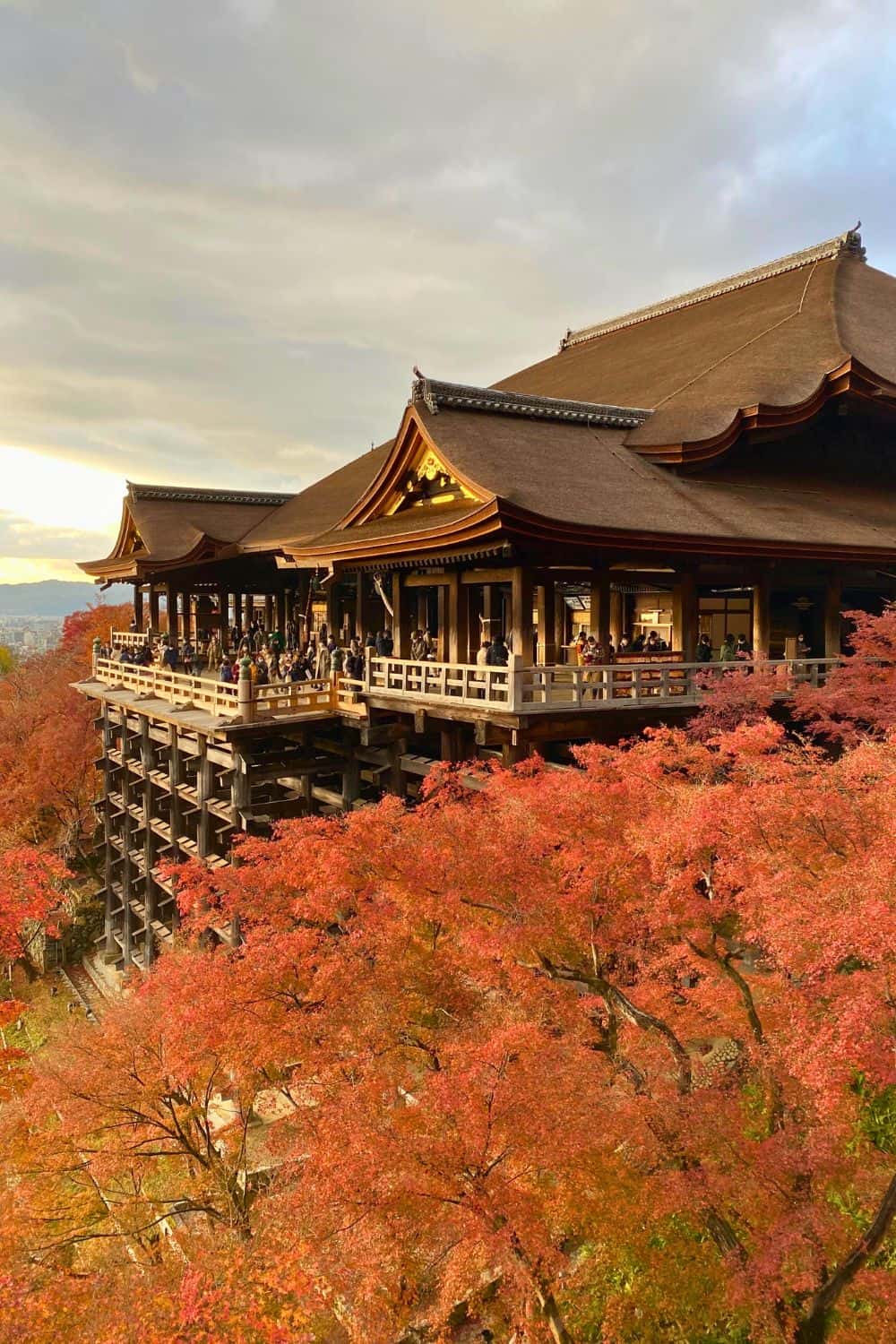
Kiyomizu-dera Temple in Autumn / Tips for First-Time Visitors to Kyoto
- Winter (December to February) – Despite the colder temperatures, winter in Kyoto has its own allure. The city is adorned with festive lights and decorations, creating a magical atmosphere. Places like Kinkaku-ji (Golden Pavilion) and Fushimi Inari Taisha shrine are particularly beautiful in the winter backdrop. The winter months also offer the opportunity to enjoy hot springs, warm up with delicious local cuisine, and experience unique New Year’s traditions.
Each season in Kyoto brings its own set of delights, so consider your preferences for weather, festivals, and natural scenery to choose the perfect time to visit and immerse yourself in the beauty and culture of this remarkable city.
Discover Arashiyama - Kyoto's Scenic Gem
Arashiyama, located on the outskirts of Kyoto, is a picturesque district renowned for its natural beauty, historic landmarks, and serene ambiance.
From the iconic bamboo grove to charming temples and the scenic Hozu River, Arashiyama offers a delightful escape from the bustling city center. To make the most of your visit, here are some valuable tips:
- When visiting Arashiyama, arrive early in the morning or late in the afternoon to avoid the crowds.
The district can become quite busy, especially during peak hours.
By arriving early, you’ll have the opportunity to enjoy the serene beauty of the bamboo grove and explore the famous attractions with a sense of tranquility. Additionally, visiting during these off-peak hours provides a better chance to capture stunning photos without large crowds in the background.

Arashiyama Bamboo Forest / Tips for First-Time Visitors to Kyoto
- As you wander through Arashiyama, take your time to soak in the tranquil atmosphere and embrace the charm of its hidden corners. Don’t miss the chance to visit the enchanting Tenryu-ji Temple, stroll along the scenic Togetsukyo Bridge, and embark on a scenic boat ride down the Hozu River.

Boat Ride on Hozu River / Tips for First-Time Visitors to Kyoto
- Consider renting a bicycle to explore Arashiyama at your own pace. Biking along the scenic paths allows you to cover more ground and discover lesser-known spots. Many rental shops are available in the area, providing a convenient way to navigate through the district and its surrounding attractions.
- If bicycling is not quite your thing, then go on a rickshaw ride. It is a lot of fun!
My recommendation is to book an Arashiyama Rickshaw Tour. This tour will take you through Bamboo Grove and some of the most scenic and historic districts in Arashiyama.

Rickshaw Ride in Arashiyama / Tips for First-Time Visitors to Kyoto
- Of all the things to do in Arashiyama, visiting Okochi Sanso Villa and strolling through the immaculately maintained garden is one of my favorite things to do.
Okochi Sanso Villa is a stunning residence of the former Japanese actor Okochi Denjiro.
Okochi Denjiro was born on February 5, 1898 in Iwaya-mura, Chikujo-gun, Fukuoka Prefecture, Japan as Masuo Oobe. He was an actor and writer, known for No Regrets for Our Youth (1946), Sanshiro Sugata (1943), and The Men Who Tread on the Tiger’s Tail (1945). He died on July 19, 1962.

Okochi Sanso Villa / Tips for First-Time Visitors to Kyoto
- Another one of my favorite things to do in Arashiyama is to take a ride on Sagano Romantic Train.
The train travels from Saga Torokko Station to Kameoka Torokko Station. It is a beautiful 7 km (25 minutes) ride along Hozukyo Ravine. The ride is fun no matter what time of the year you are visiting! Moreover, the train goes at a leisurely pace, which will allow you to take plenty of pictures.
What I like to do is to combine the Hozugawa River Boat Ride with the Sagano Romantic Train Trip, as they both run in the same area. You can take the Sagano Romantic Train one way and the Hozugawa River Boat Trip back, or vice versa.

Sagano Romantic Train / Tips for First-Time Visitors to Kyoto
Unlock the Secrets of Nijo Castle (Tips for Enchanting Visit)
Welcome to Nijo Castle, a UNESCO World Heritage site nestled in the heart of Kyoto. Steeped in history and shrouded in mystery, Nijo Castle stands as a testament to the power and intrigue of Japan’s feudal era.
As you step into this remarkable fortress, you will be transported back in time to a world of samurais, shoguns, and hidden passages.

Nijo Castle / Tips for First-Time Visitors to Kyoto
To ensure that your visit to Nijo Castle is nothing short of enchanting, we have curated a collection of tips to help you make the most of your experience. From navigating the sprawling castle grounds to uncovering its hidden treasures, get ready to unlock the secrets of Nijo Castle.
So, put on your metaphorical ninja cloak as we embark on an unforgettable journey through this historic masterpiece:
- Nijo Castle, also known as Nijō-jō in Japanese, was constructed in 1603, during the Edo period. It served as the residence and administrative center for the Tokugawa shoguns, the rulers of feudal Japan. It was originally built as a symbol of the shogun’s authority and power.
- The castle complex covers an extensive area of approximately 275,000 square meters and consists of multiple buildings, gardens, and walls. It was designed as a defensive structure with fortified walls and a moat, reflecting the turbulent times of the period. However, despite its defensive features, the castle also showcases elegant architecture and elaborate interior designs.
- The castle is renowned for its unique architectural style, blending elements of traditional Japanese design with influences from Chinese and European styles. The main buildings within the castle include the Ninomaru Palace, the Honmaru Palace, and the gardens that surround them.

Gardens at Nijo Castle / Tips for First-Time Visitors to Kyoto
- The Ninomaru Palace is the centerpiece of Nijo Castle and is famous for its “Nightingale Floors.” These floors were constructed in a way that they produce a distinctive chirping sound when walked upon, alerting occupants to the presence of potential intruders.
The palace also features beautiful sliding doors with intricate paintings depicting natural scenes, animals, and mythical creatures.

Nightingale Floors at Nijo Castle / Tips for First-Time Visitors to Kyoto
- Make sure to take a good look at the stunning Karamon Gate leading to Nijo Castle. It was the symbol of authority. It proclaimed the prestige of the buildings located behind the gate. Interestingly enough, the passage through Karamon Gate was reserved only for the shogun during his visits to the castle.
Karamon gate at Nijo Castle in Kyoto was constructed entirely of cypress bark in hip-and-gable fashion. The cypress bark would become dark brown color as it aged.
The ridges of the roof are adorned with ‘shachihoko’ – a traditional dolphin-like fish. Under the roof are intricate wood sculptures depicting luan (a mythical Chinese bird), pine trees, peonies, clouds, and blades of grass.

Karamon Gate at Nijo Castle / Tips for First-Time Visitors to Kyoto
- Throughout its history, Nijo Castle has witnessed significant historical events. In 1867, the castle served as the backdrop for the signing of the Imperial Edict, which marked the end of the shogunate and the restoration of imperial rule.
This event led to the transfer of power from the Tokugawa shogunate to the Meiji Emperor and marked a turning point in Japanese history.
- In 1939, Nijo Castle was donated to the city of Kyoto and opened to the public as a historic site. In 1994, it was designated as a UNESCO World Heritage site, recognizing its cultural and historical significance.
- Nijo Castle can attract a significant number of visitors, especially during peak hours. To avoid crowds and fully appreciate the castle’s tranquil ambiance, aim to arrive early in the morning when it opens. This will give you ample time to explore the grounds at a more leisurely pace.
- Consider joining a guided tour or renting an audio guide at the castle. These informative resources provide valuable insights into the historical significance, architectural features, and hidden stories behind Nijo Castle. They can enhance your understanding and appreciation of the site as you navigate through its various buildings and gardens.
Explore Golden Pavilion (Kinkaku-ji)
Golden Pavilion in Kyoto is a sight out of this world! A temple covered in gold with a golden phoenix standing on top when the sun hits it, you really will be in awe.

Golden Pavilion in Kyoto / Tips for First-Time Visitors to Kyoto
- The pavilion has three floors, each with its very own architectural style.
- At the very top of the Golden Pavilion sits the Phoenix. In Japanese mythology since the mid-6th century, the Phoenix is called Hō-ō. The Phoenix, or a sunbird brings goodwill as it descends from the heavens. It is, also, symbolic of an imperial household.
- Golden Pavilion is covered in real gold! The second and third stories of Golden Pavilion have approximately 48 kilograms of gold! All this gold is maintained by a single person, Takesato Yagyu.

Golden Pavilion in Kyoto / Tips for First-Time Visitors to Kyoto
Navigate Fushimi Inari Taisha Shrine with these Insider Tips and Insights
Fushimi Inari is an absolutely mesmerizing destination! Known for its vibrant vermilion torii gates, this sacred Shinto shrine offers a unique and enchanting experience.
As you step onto the path leading into the shrine, you are instantly immersed in a world of tranquility and mystique. The thousands of torii gates, arranged in a mesmerizing formation, create a captivating tunnel-like pathway that winds its way up the mountain.

Fushimi Inari Taisha in Kyoto / Tips for First-Time Visitors to Kyoto
Walking through this vermillion-hued corridor, you can’t help but feel a sense of reverence and awe. The air is filled with palpable spiritual energy as you explore the sacred grounds, passing by smaller shrines, statues, and stone lanterns that dot the pathways.
The lush greenery surrounding the shrine adds a touch of serenity, providing a picturesque backdrop to your journey.
Whether you choose to hike to the summit or explore the main trail, Fushimi Inari offers a unique opportunity to connect with the ancient traditions and cultural heritage of Japan.
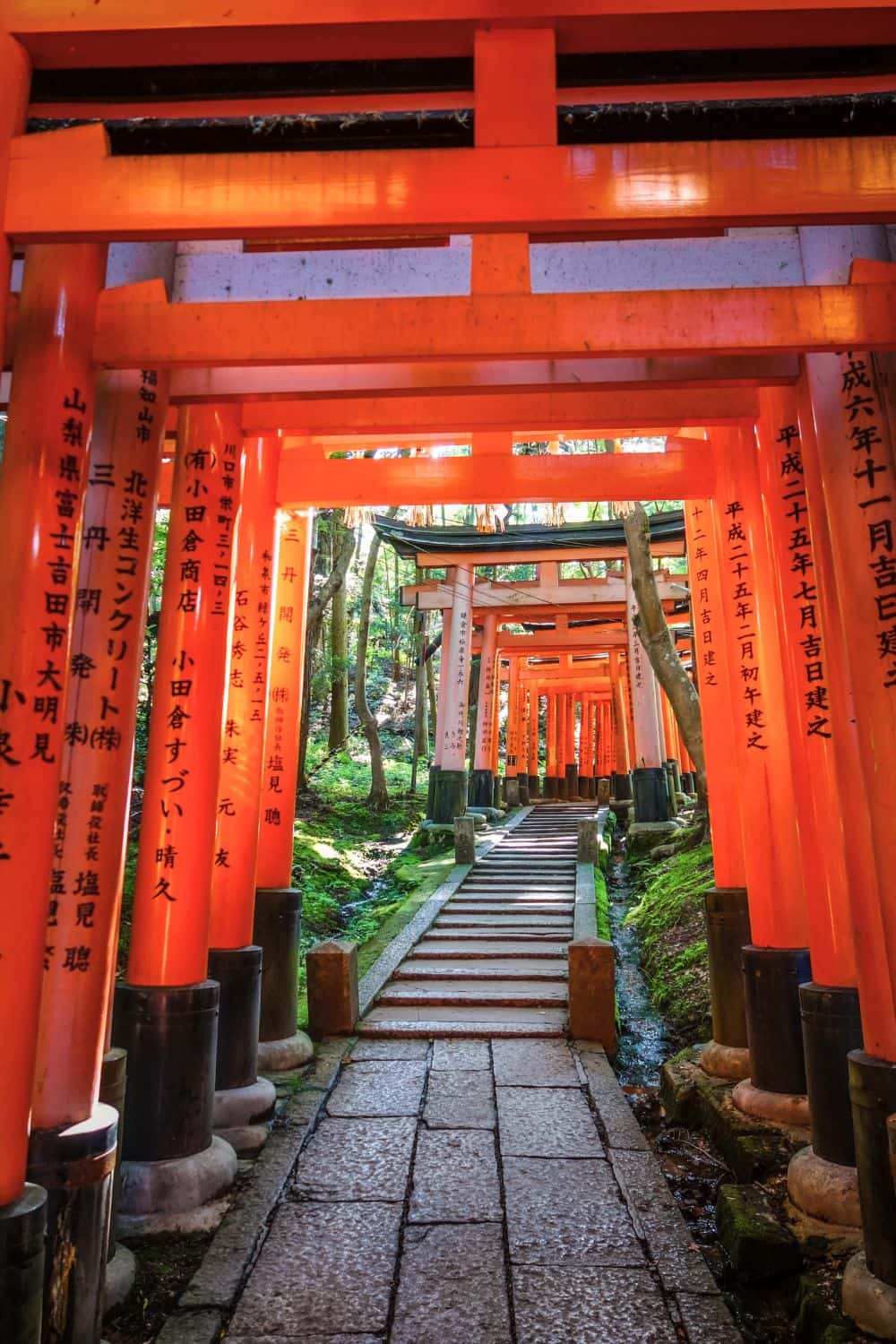
Fushimi Inari Taisha in Kyoto / Tips for First-Time Visitors to Kyoto
Here is a list of tips for visiting Fushimi Inari Shrine:
- Fushimi Inari can get crowded, so it’s best to arrive early in the morning to avoid the crowds and have a more peaceful experience.
- Be prepared for a lot of walking as you explore the shrine grounds and hike up the mountain. Comfortable shoes will make your visit more enjoyable.
- Some of the shops and food stalls at Fushimi Inari may only accept cash, so it is a good idea to have some yen on hand.
- As you venture up the mountain through the torii gates, there are not many places to purchase food or drinks. Stay hydrated and carry some snacks to keep your energy up during the hike.
- Fushimi Inari is a vast complex with numerous trails and smaller shrines. Allow yourself plenty of time to explore, take photos, and soak in the unique atmosphere.
- While the main trail with its iconic torii gates is stunning, do not be afraid to venture off the beaten path and explore some of the quieter trails. You may discover hidden treasures and enjoy a more serene experience.
- After exploring the torii gate pathway, take a moment to visit the inner shrine, Okusha, located at the summit of the mountain. It offers a different ambiance and a beautiful view of Kyoto.
- Fushimi Inari is open 24 hours, and visiting in the evening or at night can offer a unique and enchanting experience. The illuminated torii gates create a magical atmosphere worth witnessing.
Discover the Magnificence of Kiyomizu-dera Temple
Kiyomizu-dera Temple, the ‘Temple of the Pure Water Spring’. is located on Mount Otowa, in the eastern hills on the outskirts of Kyoto.
The temple belongs to the Buddhist Kita-Hosso sect and was founded in 778 CE by a priest from Nara, Enchin Shonin, who claimed to have received a vision that directed him to the exact location of a healing Otowa spring.
There is a belief that the waters of the spring have magical properties and each branch of the spring is associated with health, longevity, and exam success. If you are tempted to drink some of the healing waters, then keep in mind that in order for the magical powers to be effective, you can only choose to drink from one branch of the stream.
The temple is famous for its impressive viewing platform and the three-story Koyasu pagoda.
The viewing platform is perched on the edge of the cliff and provides a stunning view of Kyoto. The platform is built using traditional Japanese techniques without any nails.
The famous Koyasu, an impressive three-story pagoda complete with a spire, is probably the most photographed site at Kiyomizu-dera Temple. It was built between 1607 and 1633 and is designated as the National Treasure of Japan.
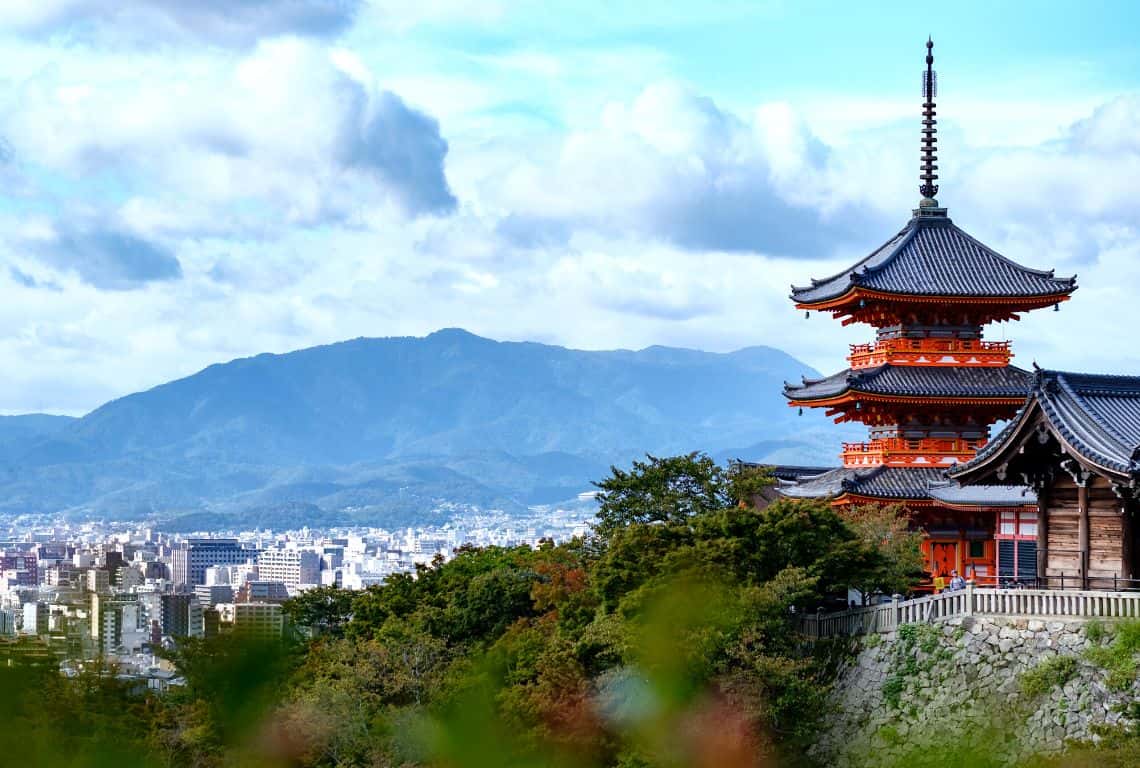
Koyasu Pagoda at Kiyomizu-dera Temple / Tips for First-Time Visitors to Kyoto
Here are some tips for visiting Kiyomizu-dera Temple:
- Kiyomizu-dera is a popular attraction, so it is best to arrive early in the morning or late in the afternoon to beat the crowds and enjoy a more peaceful experience.
- The temple grounds involve a fair amount of walking, including some steep slopes and stairs. Wear comfortable shoes to make your exploration more comfortable.
- Don’t forget to bring your camera or smartphone to capture the scenic vistas from the platform.
- Kiyomizu-dera occasionally offers special nighttime illuminations, casting the temple in a magical glow. Check the schedule here to see if you can experience this enchanting spectacle during your visit.

Nighttime Illuminations at Kiyomizu-dera Temple / Tips for First-Time Visitors to Kyoto
- Within the temple complex, you will find Jishu Shrine, dedicated to the deity of love and matchmaking. Explore the shrine and try the popular “love stones” test, where you walk between two stones with your eyes closed to find true love.
- Outside the temple, you will find a variety of food stalls offering local snacks and treats. Indulge in some Kyoto specialties like matcha-flavored sweets or freshly made yaki-soba for a delightful culinary experience.
Explore Nishiki Market - A Gastronomic Wonderland of Kyoto's Culinary Delights
Nishiki Market is a narrow covered street that stretches for five blocks and houses over a hundred shops and restaurants.
The market is known as ‘Kyoto’s Kitchen’ and you will find here many Japanese delicacies, as well as everything food-related like knives and cookware.
Nishiki Market is always packed with tourists and locals alike. It is a fun place to just browse through and try a few items. Most of the food items are in small bite-side portions displayed on wooden sticks that you can just grab and eat on the spot.
Here are some tips so that you can ace your visit to Nishiki Market:
- Arrive hungry! Nishiki Market is a food lover’s paradise, so come with an empty stomach and be prepared to indulge in a wide array of delicious treats.
- Try local specialties. Nishiki Market is famous for its regional delicacies.
My recommendation is to definitely try tako-tamago, which means octopus-egg. It is a baby octopus marinated and cooked in a sauce made of sugar, mirin, and soy sauce. In the head of the octopus is a quail’s egg.

Tako-tamago at Nishiki Market in Kyoto / Tips for First-Time Visitors to Kyoto
Another recommendation is to try tamagoyaki, which I would describe as a Japanese type of omelet filled with cooked cabbage, carrot, green and white onions, and pickled ginger.
Finally, try matcha warabi mochi from Kyoto Matcha Sweets Sawawa. These are square jellies made with green tea and powdered with matcha green tea.
If you prefer something mainstream, try any fried food or just take a visual tour of this fun place.

Fried Foods at Nishiki Market / Tips for First-Time Visitors to Kyoto
- While food is the highlight of Nishiki Market, there are other intriguing items to discover. Browse through shops selling kitchenware, traditional crafts, fresh produce, and unique souvenirs.
- Some smaller vendors may only accept cash, so it’s a good idea to have yen on hand. However, larger shops and some stalls may accept credit cards.
- If possible, plan your visit to Nishiki Market on weekdays. It tends to be less crowded compared to weekends, allowing for a more relaxed shopping and dining experience.
- My recommendation is to look into some of the small group guided walking tours through Nishiki Market. You will be accompanied by a local guide who is usually an excellent resource on what are the best places to try some of the local delicacies.
Check out Daytime Kyoto – Nishiki Market and Gion District Cultural Walking Food Tour. This tour will take you not only around Nishiki Market but also into Gion.
Another tour that is less expensive, shorter, and just focuses on Nishiki Market is Nishiki Market Brunch Walking Food Tour and you get to try a variety of different foods.
Explore Gion and Immerse Yourself in Kyoto's Traditional Charm
Gion District in Kyoto originates from the Sengoku period (1467–1615). The district was built to accommodate visitors to Yasaka Shrine (Gion Shrine).
It eventually evolved to become one of the most exclusive and well-known geisha districts in all of Japan.
The geisha in Kyoto do not refer to themselves as geisha, instead, they use the local term ‘geiko’ which means “a woman of art”.
The area is definitely worth visiting since it has preserved its traditional architecture. It is still inhabited and alive with shops and restaurants.
Here are some tips for visiting Gion:
- The best time to visit the Gion District is definitely in the evening. The narrow streets illuminated by the street lights have a very special charm. If you are lucky, you. might catch glimpse of geiko rushing to an evening engagement.

Gion District / Tips for First-Time Visitors to Kyoto
- Make sure to explore Hanamikoji Street. It is a historic street is the heart of Gion and lined with beautifully preserved machiya (traditional wooden townhouses).
- Visit Yasaka Shrine which is located at the east end of Shijo-dori Street. Yasaka Shrine is one of Kyoto’s most famous shrines. It’s especially lively during festival times, such as the Gion Matsuri in July.
- Gion is an excellent place to indulge in Kyoto’s traditional cuisine. Look for restaurants that serve kaiseki (multi-course traditional meals) or try local specialties like yudofu (tofu hot pot) or wagashi (traditional Japanese sweets). Some establishments even offer dining experiences accompanied by geisha performances.
- Take a walk along the Shirakawa Canal. The canal is a picturesque waterway that runs through Gion. Strolling along its banks, especially during cherry blossom season in spring or autumn foliage season, offers a tranquil experience and breathtaking views of the surrounding architecture.
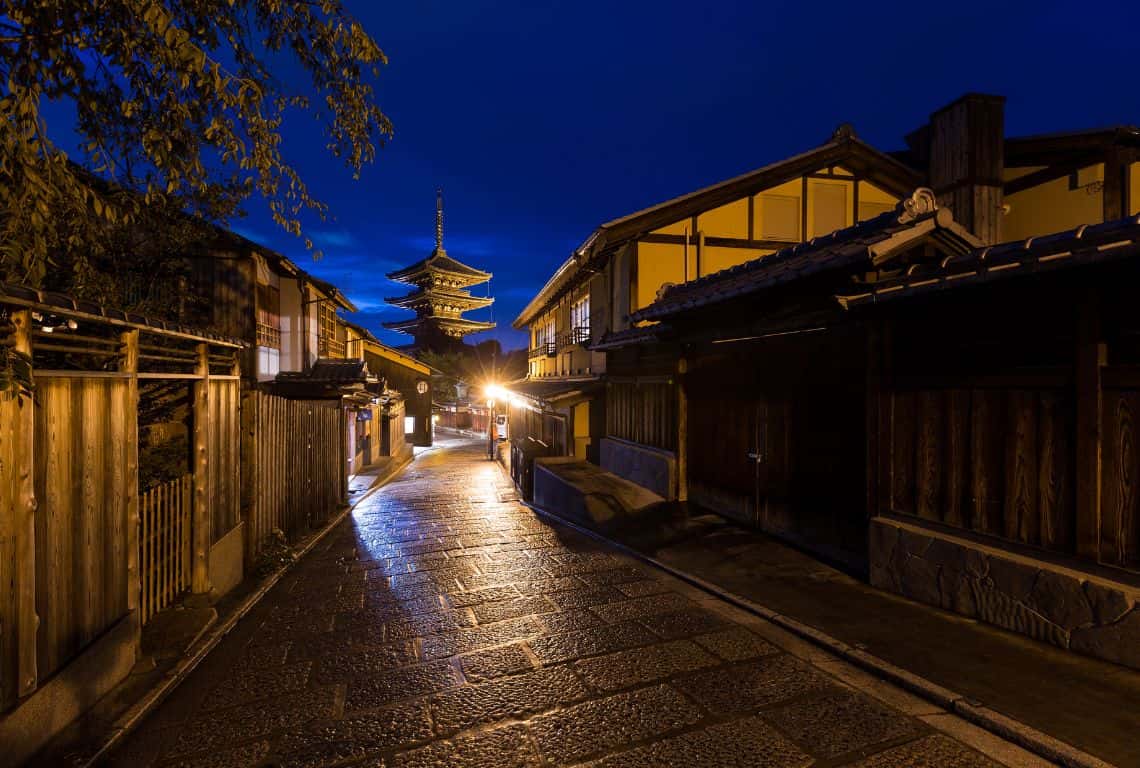
Gion District in the Evening / Tips for First-Time Visitors to Kyoto
- If you’re interested in traditional Japanese performing arts, consider attending a performance at Gion Corner. Here, you can witness various art forms like tea ceremonies, flower arrangements, traditional dance, and more, all in one place.
- Gion is renowned for its tea houses where you can experience a traditional Japanese tea ceremony. These ceremonies are deeply rooted in Japanese culture and offer a glimpse into the world of matcha tea preparation.
Book a tea ceremony in advance to ensure a spot. Here is a tea ceremony I enjoyed: Traditional Tea Ceremony wearing a Kimono in Kyoto by MAIKOYA. You will learn about Japanese history and sample matcha green tea, plus wearing a traditional kimono.
Traditional Japanese Tea Ceremony
Reflect Along the Philosopher's Path
Philosopher’s Path, known as Tetsugaku no Michi, is a delightful path that stretches for about 2 kilometers and meanders along the Lake Biwa Canal.
The path was named for Kyoto University professor and influential 20th-century Japanese philosopher Nishida Kitaro, who is said to have used this route for a daily meditative walk,
The scenery is stunning along the way. It is especially beautiful if you are visiting during the spring months when the cherry blossom trees that line the path are in full bloom.
The path passes by some of the most impressive shrines and temples that are just a few steps away from the path and definitely worth a quick stop.
There are plenty of restaurants and coffee houses along the way as well, perfect for taking a short break.

Philosopher’s Path in Springtime / Tips for First-Time Visitors to Kyoto
Here are some tips for taking a walk along Philosper’s Path:
- Begin your journey at Ginkaku-ji (Silver Pavilion) and walk south towards Nanzen-ji Temple. This direction allows you to follow the flow of the canal and enjoy the gradual transition of scenery along the path.
- The Philosopher’s Path is meant to be savored at a leisurely pace. Allow yourself ample time to stroll, appreciate the surroundings, and soak in the peaceful atmosphere.
- Take the opportunity to explore the temples and shrines located near the Philosopher’s Path, such as Ginkaku-ji, Honen-in Temple, Eikan-do Zenrin-ji Temple, and Nanzen-ji Temple.
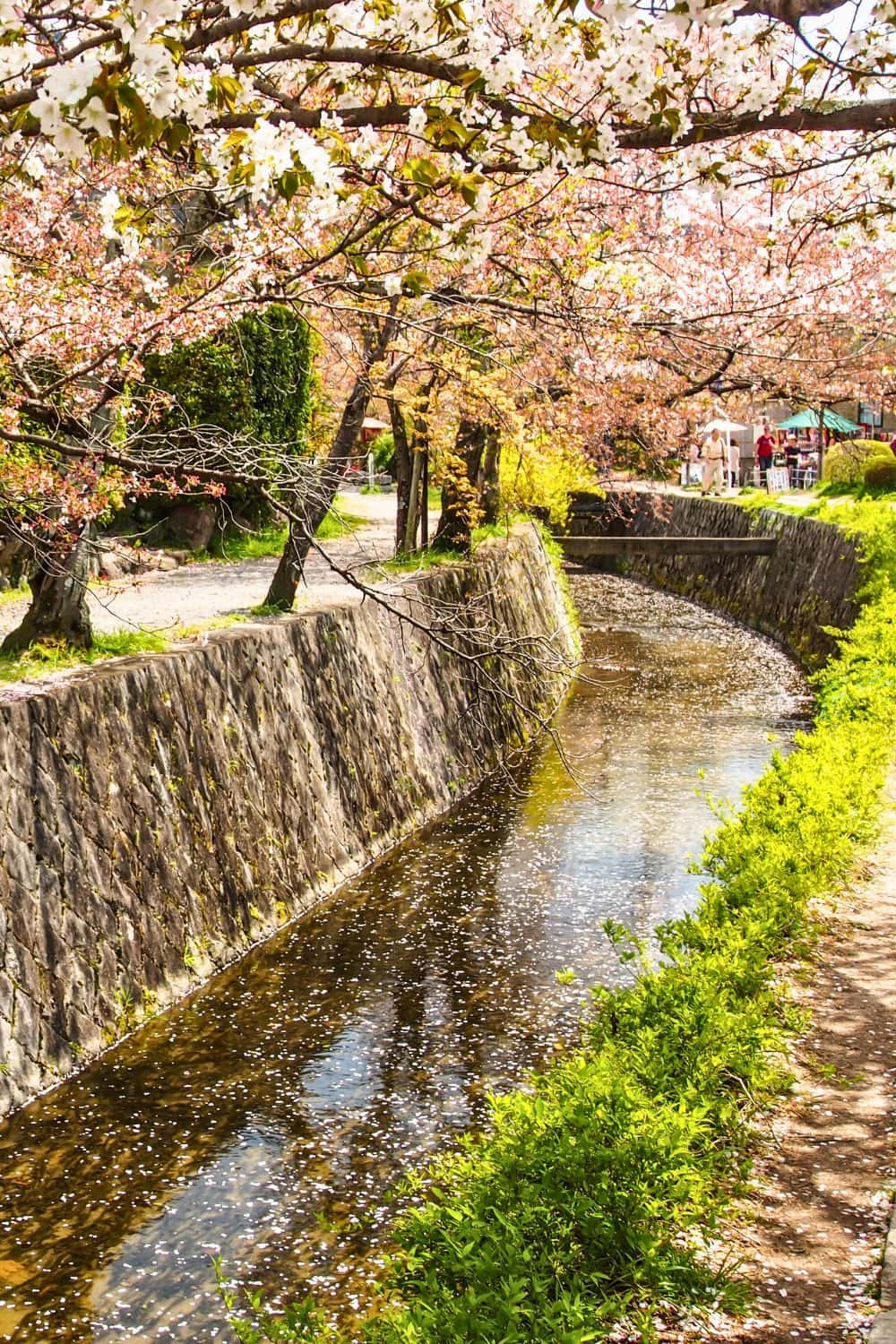
Philosopher’s Path in Springtime / Tips for First-Time Visitors to Kyoto
Visit Kyoto's Ginkaku-ji (Silver Pavilion)
Ginkaku-ji Temple (Silver Pavilion), officially known as Jishō-ji or “Temple of Shining Mercy”), is one of the constructions that represents the Higashiyama Culture of the Muromachi period.
The Silver Pavilion was originally constructed in 1482 as a retirement villa for Shogun Ashikaga Yoshimasa. It was modeled after the Golden Pavilion which was built for the shogun’s grandfather.
Following the death of Yoshimasa, the villa was converted into a temple.
Although the temple is called the Silver Pavilion, it was never covered in silver. Needless to say, it is a stunning temple and absolutely worth a visit.
The temple consists of a two-story pavilion officially known as the Kannon Hall and dedicated to Kannon, the Buddhist goddess of mercy. However, the highlight of the visit is the two gardens surrounding the temple.
Especially stunning is the sand garden known as the “Sea of Silver Sand” which has been immaculately raked to beautiful effect. In the middle of it is a sand sculpture that is meant to represent Mt Fuji.

Silver Pavilion in Kyoto / Tips for First-Time Visitors to Kyoto
Here are some tips for visiting:
- Take your time to wander through the meticulously designed garden surrounding Ginkaku-ji. Admire the carefully raked sand patterns, lush greenery, and beautiful rock formations. Don’t miss the iconic sand cone known as the “Moon Viewing Platform” which offers a stunning view of the temple and its surroundings.
- Ginkaku-ji is located at the northern end of the Philosopher’s Path, a scenic trail lined with cherry trees. Consider starting your journey at Ginkaku-ji and walking along this path, immersing yourself in the serene atmosphere and enjoying the beauty of nature along the way.
- Ginkaku-ji is known for its minimalist and refined design, reflecting the principles of wabi-sabi, an aesthetic concept centered around imperfection and transience. Appreciate the simple elegance of the temple’s architecture and gardens, which showcase the beauty in understated elements.
- Ginkaku-ji houses a tea house where you can experience a traditional Japanese tea ceremony. This offers a unique opportunity to participate in a cultural ritual and enjoy matcha tea in a serene setting. Reservations are recommended, so plan ahead.

Sand Garden at the Silver Pavilion in Kyoto / Tips for First-Time Visitors to Kyoto
Explore Pontocho - Kyoto's Enchanting Geisha District
Pontocho, a hidden gem nestled in the heart of Kyoto, is a place where time seems to stand still.
This enchanting narrow alley, lined with traditional machiya townhouses and illuminated lanterns, exudes an old-world charm that will transport you to a bygone era.
As one of Kyoto’s most renowned geisha districts, Pontocho offers a glimpse into the world of geisha and maiko, where artistry, grace, and refined entertainment thrive.
With its vibrant culinary scene, traditional teahouses, and the gentle flow of the Kamogawa River nearby, Pontocho is a destination that captivates the senses and will immerse you in the elegance and allure of Kyoto’s cultural heritage.
Step into Pontocho’s magical streets, and embark on a journey of discovery, where tradition and beauty intertwine in an experience like no other.
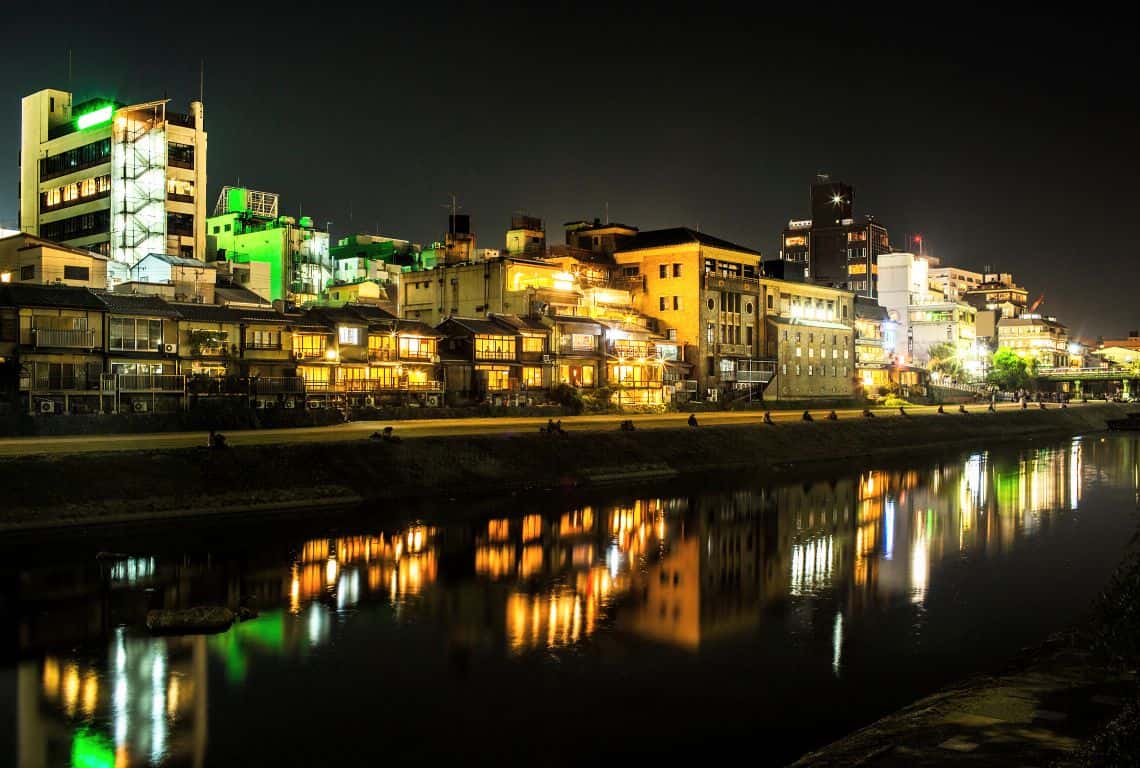
Pontocho Area in Kyoto / Tips for First- Time Visitors to Kyoto
Here are some useful tips for visiting Pontocho:
- Pontocho truly comes alive in the evening when the lanterns are lit, creating a magical atmosphere. The narrow streets are often filled with the sounds of traditional music and the sight of elegantly dressed geisha and maiko making their way to appointments. Plan your visit for the evening to witness the district’s enchanting allure.
- Pontocho is renowned for its dining establishments, ranging from traditional kaiseki restaurants to modern izakayas. Indulge in Kyoto’s famous culinary delights, such as kaiseki (multi-course traditional meal), yakitori (grilled skewers), or sushi. Try the local specialty of Kamogawa Nabe, a hot pot dish made with Kyoto vegetables and river fish.

Pontocho Area in Kyoto / Tips for First-Time Visitors to Kyoto
- Pontocho is situated along the Kamogawa River, which adds to the district’s charm. Consider dining at a riverside restaurant or finding a spot along the riverbank to enjoy the tranquil view. During the summer months, some establishments set up open-air seating areas called “yuka,” providing a unique dining experience.
- Adjacent to Pontocho, Kiyamachi Street offers a similar atmosphere and a chance to explore more shops and restaurants. Take a leisurely walk along Kiyamachi Street to discover additional hidden gems and extend your exploration beyond Pontocho.
Intrepid Scout's Tips for First Visit to Kyoto
That is quite a list of things to do in Kyoto on your first visit. What if you only have time to see a couple of things? Then, my recommendation is to make sure that on your first visit to Kyoto you do not miss:
- Fushimi Inari Tashia – it is a visually stunning place. You will be in awe and you will be taking hundreds of pictures at every corner.
Make sure to check out my detailed post: Amazing Fushimi Inari in Kyoto (8 Things to Know Before You Visit)
- Golden Pavilion – it is definitely a stunning sight to see a pavilion covered in gold.
Here is a post that you need to read before going: Stunning Golden Pavilion in Kyoto (How to Visit and What to See)
- Tea Ceremony (with wearing a kimono) – if your time allows, then make sure to attend a tea ceremony and wear a kimono. It is one of a kind experience that will teach you a lot about Japanese culture.
My recommendation is to look into the Traditional Tea Ceremony and wear a Kimono in Kyoto MAIKOYA. If your budget allows you to splurge a little, then check out PRIVATE Geisha (Maiko) Tea Ceremony and Geisha Performance.
Now, It Is Your Turn, I Would Like to Hear Back from You!
Are you planning your trip to Kyoto?
Please let me know! Drop me a quick comment right below!
Click on any of the images below to get inspired and to help you with the planning process for your trip to Kyoto!
More Posts About Japan:
Perfect ONE DAY in KANAZAWA – 7 Things to Do (BEST TRIP from Tokyo, Kyoto, or Osaka)
14 Amazing Things to Do in Arashiyama (Map+Useful Tips)
What to See at Nijo Castle in Kyoto (10 Top Things to Know)
Stunning Golden Pavilion in Kyoto (How to Visit and What to See)
Amazing Fushimi Inari Taisha in Kyoto (8 Things to Know Before You Visit)
Perfect Day Trip to Miyajima from Kyoto, Osaka, or Hiroshima
Did You Find Tips for First-Time Visitors to Kyoto Useful?
Why Not Save It to Your Pinterest Board!

